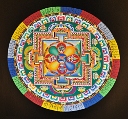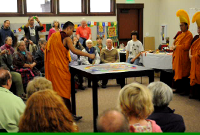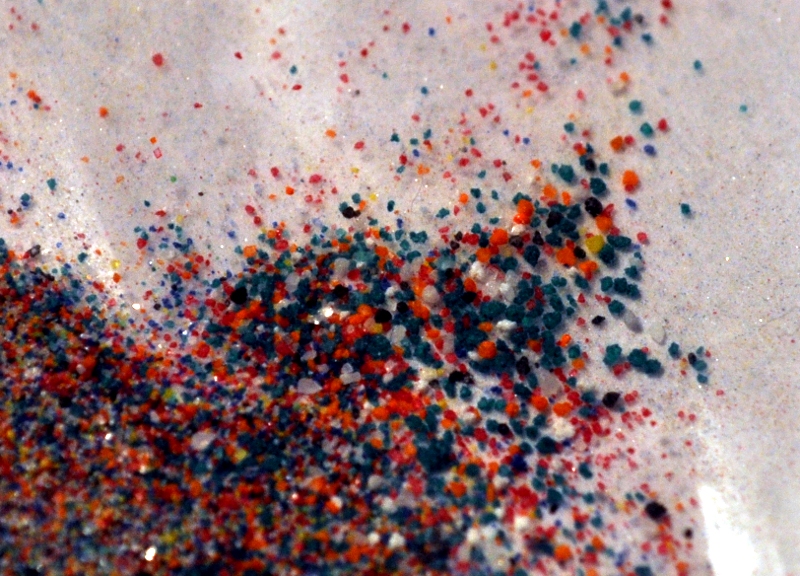This Floating World
 We had heard that Tibetan Buddhist monks were up in Springdale this past week, and were constructing a traditional Tibetan mandala sand painting. On Saturday November 20 we drove up to watch the monks put their finishing touches on the elaborate and delicate mandala. The purpose of this ceremony is to emphasize the transient nature of life and all phenomena. The mandala that the monks constructed here in Springdale was a representation of the bodhisattva Avalokiteshvara, who embodies Buddhist principle of Compassion, and is also regarded as the patron deity of Tibet. This picture (above) is the best photo I was able to take of their final work, and it still does not capture the lush color and beauty of the painting that sat on the table before us.
We had heard that Tibetan Buddhist monks were up in Springdale this past week, and were constructing a traditional Tibetan mandala sand painting. On Saturday November 20 we drove up to watch the monks put their finishing touches on the elaborate and delicate mandala. The purpose of this ceremony is to emphasize the transient nature of life and all phenomena. The mandala that the monks constructed here in Springdale was a representation of the bodhisattva Avalokiteshvara, who embodies Buddhist principle of Compassion, and is also regarded as the patron deity of Tibet. This picture (above) is the best photo I was able to take of their final work, and it still does not capture the lush color and beauty of the painting that sat on the table before us.
 When we arrived at the Canyon Community Center the monks were in the final stages of the project, under the watchful gaze of a photo of the Dalai Lama in a small altar on the stage. The large hall was filled with the sound of monks chanting and throat-singing as they concentrated on the task of dropping individual grains of sand onto the painting. The instrument that they used to do this was a thin hollow metal tube called a chak-pur, which had a sort of washboard edge that the monks would scrape rapidly with a stick.
When we arrived at the Canyon Community Center the monks were in the final stages of the project, under the watchful gaze of a photo of the Dalai Lama in a small altar on the stage. The large hall was filled with the sound of monks chanting and throat-singing as they concentrated on the task of dropping individual grains of sand onto the painting. The instrument that they used to do this was a thin hollow metal tube called a chak-pur, which had a sort of washboard edge that the monks would scrape rapidly with a stick.
![]() This produced an intriguing almost musical sound, though its main purpose was to cause the sand to flow out of the end of the tube and onto the painting. In this recording you can hear the chanting of the monks and the scraping of the sticks on the washboard surface of the tubes; I like that the incidental sounds of children talking is mixed in, with the rumble of conversation. The esoteric and the divine, integrated seamlessly with everyday life. There is no difference between the two, they seemed to say, and it did not matter who you were — even the fundamentalist Mormon women, in their robin’s egg blue prairie dresses, came to watch and admire the work of these Buddhist monks.
This produced an intriguing almost musical sound, though its main purpose was to cause the sand to flow out of the end of the tube and onto the painting. In this recording you can hear the chanting of the monks and the scraping of the sticks on the washboard surface of the tubes; I like that the incidental sounds of children talking is mixed in, with the rumble of conversation. The esoteric and the divine, integrated seamlessly with everyday life. There is no difference between the two, they seemed to say, and it did not matter who you were — even the fundamentalist Mormon women, in their robin’s egg blue prairie dresses, came to watch and admire the work of these Buddhist monks.
 After the monks had completed the mandala, they allowed the public to observe the painting for one hour before they destroyed it with a brush, gathering all the colored sand into a dull gray pile. Half of the sand was placed into small plastic bags for those observers who wanted them, and the rest was poured into the Virgin river. We took a small bag of the sand home with us.
After the monks had completed the mandala, they allowed the public to observe the painting for one hour before they destroyed it with a brush, gathering all the colored sand into a dull gray pile. Half of the sand was placed into small plastic bags for those observers who wanted them, and the rest was poured into the Virgin river. We took a small bag of the sand home with us.
 Though from a distance the blended sand appears gray, on close inspection you can still see the individual colors of each grain that went into the painting. By my estimate the average grains are a few thousandths of an inch in diameter, and so the number of grains in the entire painting must have been somewhere around a hundred billion, or roughly the same as the number of stars in the galaxy. It would take a very long time to try to sort these grains back out into the original colors and reconstruct a similar painting, and of course you shouldn’t try.
Though from a distance the blended sand appears gray, on close inspection you can still see the individual colors of each grain that went into the painting. By my estimate the average grains are a few thousandths of an inch in diameter, and so the number of grains in the entire painting must have been somewhere around a hundred billion, or roughly the same as the number of stars in the galaxy. It would take a very long time to try to sort these grains back out into the original colors and reconstruct a similar painting, and of course you shouldn’t try.
It has now been five months to the day since my mother passed away. One week she was lying in a hospital bed, alive and joking with us all, full of life and colorful personality, and the next Monday all that was left was a small three by five by eight inch box of ashes. The box seemed so light in my hand; how is it possible that this gray dust was once Lucille? I do not know. All I know is, the simple knowledge that a sand painting would only exist in its current form for one hour on a wooden table in Springdale Utah on November 20 made me appreciate each moment that it existed, and made me poignantly aware of the amazing thing of beauty that it was and to appreciate what joy it brought to people in its tiny span of existence in this wild floating world we call home.
